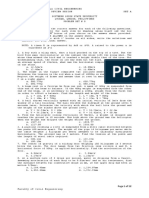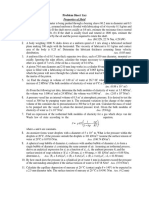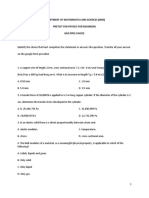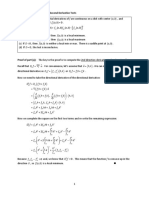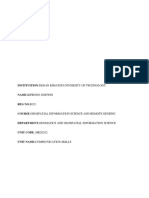Assignment 2
Uploaded by
Clement KipyegonAssignment 2
Uploaded by
Clement Kipyegonu 3 y 1 y2
1. The velocity distribution in the boundary layer is given by = − ,δ being boundary
U 2 δ 2 δ2
layer thickness. Calculate.
i. The ratio of displacement thickness to boundary thickness.
ii. The ratio of momentum thickness to boundary layer thickness.
2. A plate 450mm by 150mm has been placed longitudinally in a stream of crude oil (specific
gravity 0.925 and kinematic viscosity of 0.9 stoke) which flows with velocity of 6 m/s.
Calculate:
i. The friction drag of plate.
ii. Thickness of boundary layer at the trailing edge.
iii. Shear stress at the trailing edge.
3. A submarine can be assumed to have cylindrical shape with rounded nose, assuming its length to
be 50 m and diameter 5.0 m, determine the total power required to overcome boundary friction if
kg
0
(
it cruises at 8 m/s velocity in sea water at20 C ρ=1030
m3 )
, v=1× 10−6 m2 /s.
4. Explain what is meant by separation of boundary layer. Describe with sketches the methods to
control separation.
5. On a flat of 2 m (length) by 1 m (width), experiment were conducted in a wind tunnel with a wind
speed of 50 km/h. The plate is kept at such an angle that the co-efficient of drag and lift are 0.8
and 0.9 respectively. Take density of air ¿ 1.15 kg /m 3
Determine:
i. Drag force,
ii. Lift force,
iii. Resultant force,
iv. Power exerted by the airstream on the plate.
6. An aeroplane weighing 39.42 KN is flying in a horizontal direction at 360 km/h. the plane spans
15m and has wing surface of 35 m2. If drag co-efficient CD= 0.03 and for air ρ=1.22kg /m 3,
Determine:
i. Co-efficient of lift
ii. Power required to drive the plane
iii. Theoretical value of the boundary layer circulation.
You might also like
- ECM3166 - Communications Engineering Laboratory Assignment Baseband Pulse SignallingNo ratings yetECM3166 - Communications Engineering Laboratory Assignment Baseband Pulse Signalling4 pages
- CHG 503 Tutorial 2 - Boundary Layer - 220129 - 215132No ratings yetCHG 503 Tutorial 2 - Boundary Layer - 220129 - 2151323 pages
- ASSG2 FLUIDS MECHANICS 2 (bmm2543) SEM 2 - 2010 2011No ratings yetASSG2 FLUIDS MECHANICS 2 (bmm2543) SEM 2 - 2010 20112 pages
- Questions On Solids, Liquids and Gases in Physics With AnswersNo ratings yetQuestions On Solids, Liquids and Gases in Physics With Answers13 pages
- Mining Methods Test Paper 2 Mechanical Methods PDFNo ratings yetMining Methods Test Paper 2 Mechanical Methods PDF1 page
- Boundary Layer Theory Problems Sheet - I - 2017 - 18100% (1)Boundary Layer Theory Problems Sheet - I - 2017 - 181 page
- TUTORIAL - 2 and 3 - FME - FPE 111 - PHYSICS 1A - 2021-2022No ratings yetTUTORIAL - 2 and 3 - FME - FPE 111 - PHYSICS 1A - 2021-20224 pages
- Phy-xi Target Paper (2025) -Zain'II GroupNo ratings yetPhy-xi Target Paper (2025) -Zain'II Group7 pages
- MSTE 6 Physics For Engineers, Advanced Engg MathNo ratings yetMSTE 6 Physics For Engineers, Advanced Engg Math5 pages
- Iut Admission Test 2016.2017 Question Paper: PhysicsNo ratings yetIut Admission Test 2016.2017 Question Paper: Physics13 pages
- EME 4353 Fluid Mechanics II Assignment Dec 2024No ratings yetEME 4353 Fluid Mechanics II Assignment Dec 20242 pages
- Math 163 11.7 Second Derivative Tests: X y XX Yy XyNo ratings yetMath 163 11.7 Second Derivative Tests: X y XX Yy Xy2 pages
- Orthomosaic and DEM Generation With Agisoft PhotoScan TutorialNo ratings yetOrthomosaic and DEM Generation With Agisoft PhotoScan Tutorial20 pages
- Instituition:Dedan Kimathi University of TechnologyNo ratings yetInstituition:Dedan Kimathi University of Technology8 pages
- (6 Points) : Data Diary Project STAT 113: Statistics and Society 35 Points TotalNo ratings yet(6 Points) : Data Diary Project STAT 113: Statistics and Society 35 Points Total2 pages
- Design of Children'S Playground EquipmentsNo ratings yetDesign of Children'S Playground Equipments9 pages
